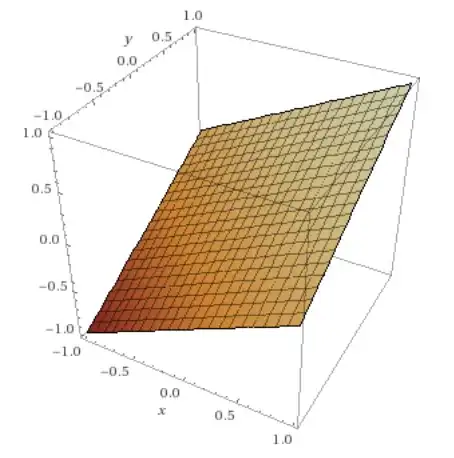Is there any need to use a non-linear activation function (ReLU, LeakyReLU, Sigmoid, etc.) if the result of the convolution layer is passed through the sliding window max function, like max-pooling, which is non-linear itself? What about the average pooling?
1 Answers
Let's first recapitulate why the function that calculates the maximum between two or more numbers, $z=\operatorname{max}(x_1, x_2)$, is not a linear function.
A linear function is defined as $y=f(x) = ax + b$, so $y$ linearly increases with $x$. Visually, $f$ corresponds to a straight line (or hyperplane, in the case of 2 or more input variables).
If $z$ does not correspond to such a straight line (or hyperplane), then it cannot be a linear function (by definition).
Let $x_1 = 1$ and let $x_2 \in [0, 2]$. Then $z=\operatorname{max}(x_1, x_2) = x_1$ for all $x_2 \in [0, 1]$. In other words, for the sub-range $x_2 \in [0, 1]$, the maximum between $x_1$ and $x_2$ is a constant function (a horizontal line at $x_1=1$). However, for the sub-range $x_2 \in [1, 2]$, $z$ correspond to $x_2$, that is, $z$ linearly increases with $x_2$. Given that max is not a linear function in a special case, it can't also be a linear function in general.
Here's a plot (computed with Wolfram Alpha) of the maximum between two numbers (so it is clearly a function of two variables, hence the plot is 3D).
Note that, in this plot, both variables, $x$ and $y$, can linearly increase, as opposed to having one of the variables fixed (which I used only to give you a simple and hopefully intuitive example that the maximum is not a linear function).
In the case of convolution networks, although max-pooling is a non-linear operation, it is primarily used to reduce the dimensionality of the input, so that to reduce overfitting and computation. In any case, max-pooling doesn't non-linearly transform the input element-wise.
The average function is a linear function because it linearly increases with the inputs. Here's a plot of the average between two numbers, which is clearly a hyperplane.
In the case of convolution networks, the average pooling is also used to reduce the dimensionality.
To answer your question more directly, the non-linearity is usually applied element-wise, but neither max-pooling nor average pooling can do that (even if you downsample with a $1 \times 1$ window, i.e. you do not downsample at all).
Nevertheless, you don't necessarily need a non-linear activation function after the convolution operation (if you use max-pooling), but the performance will be worse than if you use a non-linear activation, as reported in the paper Systematic evaluation of CNN advances on the ImageNet (figure 2).
- 39,006
- 12
- 98
- 176
-
Is the same not true for ReLU? And even more so for LeakyReLU? – Kasia Feb 10 '20 at 00:10
-
@Kasia What exactly are you referring to? – nbro Feb 10 '20 at 00:12
-
ReLU is simply a max function. Couldn't it basically be considered a max-pool with additional constant dimension? – Kasia Feb 10 '20 at 00:31
-
@Kasia In max-pooling, conceptually, you slide a window. When you apply ReLU you do not slide any window. It's true that ReLU is a max between 0 and the input, but I fail to understand how you want to make it a pooling operation. – nbro Feb 10 '20 at 01:34
-
I think the OP is confused about the apparent piecewise linearity of pooling and ReLu. Although relu is partly linear pooling is not since the node selected maybe exchanged. – Feb 10 '20 at 05:08
-
@DuttA So I spent a day thinking about it. In an intuitive approach, ReLU is something like an on/off for gradient flow. Either lets it go through freely, or turns it off completely. In the same way max-pool allows the gradient to flow freely through the maximum value, and blocks it for all the other values inside the sliding window. That' s the resemblance I see. – Kasia Feb 10 '20 at 19:20
-
@Kasia Yes, the [derivative of the ReLU](https://stats.stackexchange.com/q/333394/82135) is consistent with your description. – nbro Feb 10 '20 at 20:10
-
@Kasia it depends though about pooling. A node not selected as the max node may become the max node when you slide the window. So there is no absolute way to tell whether the node will be blocked with only 1 pooling operation. – Feb 11 '20 at 02:42

